
Privacy-Preserving AI: Techniques & Frameworks
Build AI systems that protect user data and meet GDPR/CCPA requirements using proven techniques and ready-to-use frameworks.

Written by
Adam Stewart
Key Points
- Stack privacy techniques for stronger data protection across your AI systems
- Use TensorFlow Privacy and OpenMined instead of building solutions from scratch
- Balance privacy requirements with AI performance using hybrid approaches
- Meet GDPR/CCPA rules while keeping the insights your business needs
Privacy-preserving AI enables organizations to harness the power of AI while protecting sensitive data and respecting individual privacy rights. This approach is crucial in today's data-driven world, where traditional AI techniques often require large datasets, raising privacy concerns.
Related video from YouTube
Key Benefits of Privacy-Preserving AI
- Data Protection: Safeguards sensitive personal information from exposure
- Customer Trust: Prioritizing privacy builds customer loyalty and confidence
- Regulatory Compliance: Helps organizations meet data privacy laws like GDPR and CCPA
- Reputation Preservation: Reduces risks of data breaches and associated reputational damage
Core Privacy-Preserving Techniques
| Technique | Description | Advantages | Disadvantages |
|---|---|---|---|
| Differential Privacy | Adds controlled noise to data, ensuring outputs don't reveal individual information | Strong privacy guarantees, quantifies privacy loss | May reduce data utility, computationally expensive |
| Homomorphic Encryption | Performs computations on encrypted data without decrypting | Ensures data confidentiality, high security | Significant computational overhead, efficiency challenges |
| Secure Multi-Party Computation | Enables collaborative computations without revealing individual inputs | Protects privacy in distributed settings | Computationally intensive, scalability limitations |
| Federated Learning | Trains models on decentralized data without centralization | Sensitive data never leaves device, useful for distributed data | Potential communication overhead |
| Hybrid Approaches | Combines multiple techniques to leverage their strengths | Stronger privacy guarantees, better utility trade-offs | Increased complexity, careful design required |
Popular Privacy-Preserving AI Frameworks
| Framework | Description | Ease of Use | Performance | Supported Techniques |
|---|---|---|---|---|
| TensorFlow Privacy | Differentially private machine learning | Medium | High | Differential Privacy |
| OpenMined | Private and secure machine learning | Medium | High | Federated Learning, Differential Privacy |
| PySyft | Secure and private deep learning | Easy | Medium | Federated Learning, Differential Privacy |
As AI continues to evolve, adopting privacy-preserving techniques will be essential for responsible and ethical AI use that benefits society while respecting individual privacy rights.
Understanding Privacy-Preserving AI
The Basics
Privacy-preserving AI protects personal data privacy during machine learning processes. It allows gaining insights from data without revealing sensitive information, respecting individual privacy rights. This approach is crucial today, where traditional AI often requires large datasets for training, raising privacy concerns.
Privacy-preserving AI minimizes data collection and processing risks. It incorporates privacy into AI models, balancing AI benefits with protecting individual privacy.
Privacy Models
Privacy-preserving AI uses several privacy models, including:
- Differential Privacy: Adds noise to data to prevent re-identification, ensuring computations don't reveal too much about any individual's data.
- K-Anonymity: Ensures an individual's data can't be distinguished from at least k-1 other individuals.
- L-Diversity: Ensures an individual's data isn't uniquely identifiable, even with background knowledge.
These models provide a framework for developing privacy-protecting AI models.
Business Importance
Privacy-preserving AI is crucial for businesses handling sensitive customer data. With increasing data breaches and privacy regulations, organizations must prioritize data privacy to maintain customer trust and avoid legal issues. By adopting privacy-preserving AI, businesses can:
| Benefit | Description |
|---|---|
| Enhance Customer Trust | Protecting customer data builds trust and loyalty. |
| Comply with Regulations | Helps organizations comply with data privacy regulations like GDPR and CCPA. |
| Reduce Legal Liabilities | Protecting data privacy reduces legal risks and reputational damage. |
In today's digital landscape, privacy-preserving AI is essential for businesses that want to maintain a competitive edge while respecting individual privacy rights.
sbb-itb-ef0082b
Key Privacy-Preserving Techniques
Privacy-preserving AI uses various methods to protect sensitive data while allowing AI models to extract valuable insights. The main techniques include:
Differential Privacy
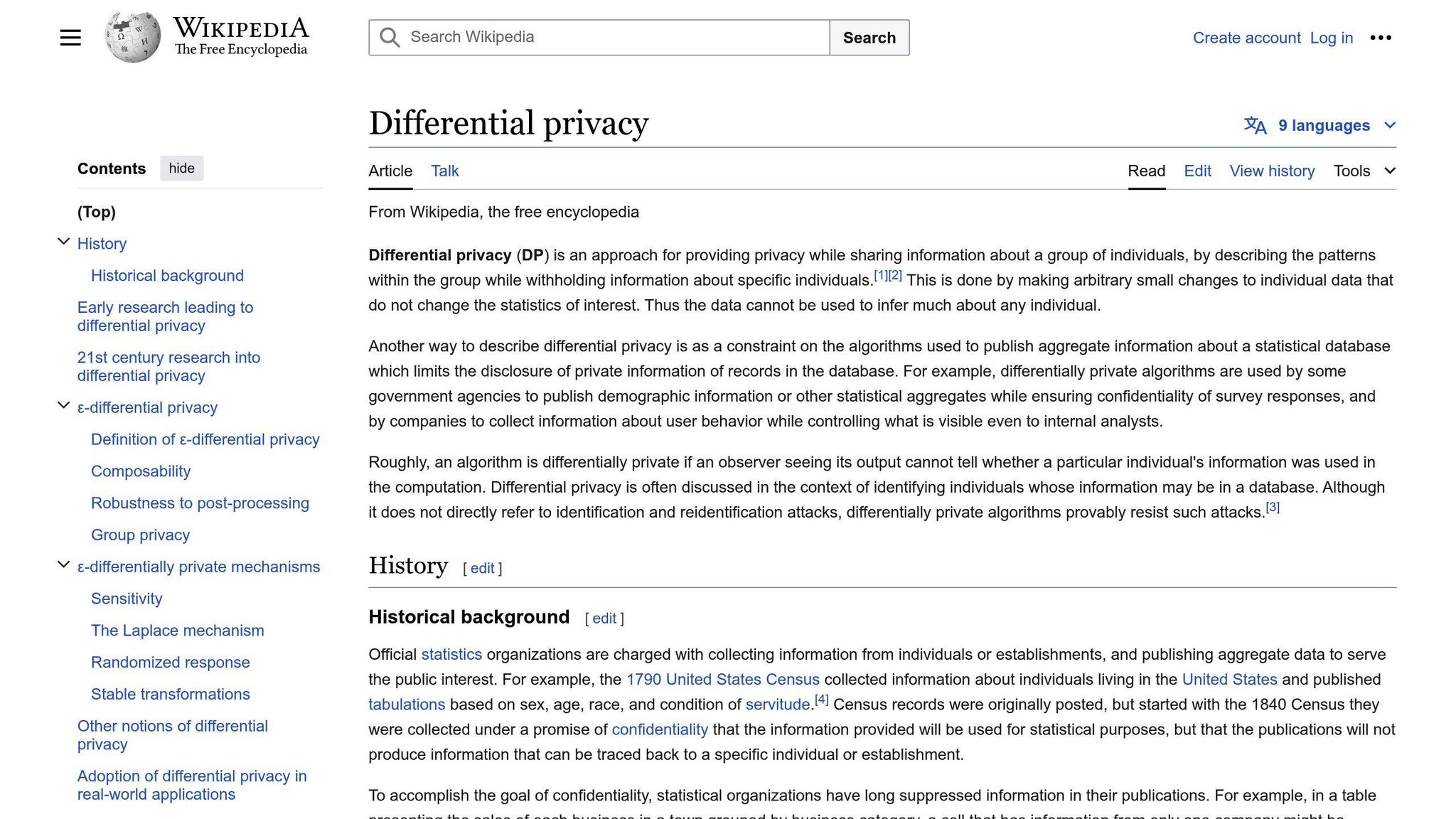
Differential privacy adds controlled noise to data, ensuring the analysis output does not reveal information about any individual in the dataset. It provides strong privacy guarantees by quantifying the privacy loss and allowing a trade-off between privacy and utility.
The core idea is to randomize the data or model outputs in a controlled way, making it extremely difficult to identify any individual's contribution. Differential privacy mechanisms, like the Gaussian mechanism and the Laplace mechanism, are used to achieve this privacy protection.
Homomorphic Encryption
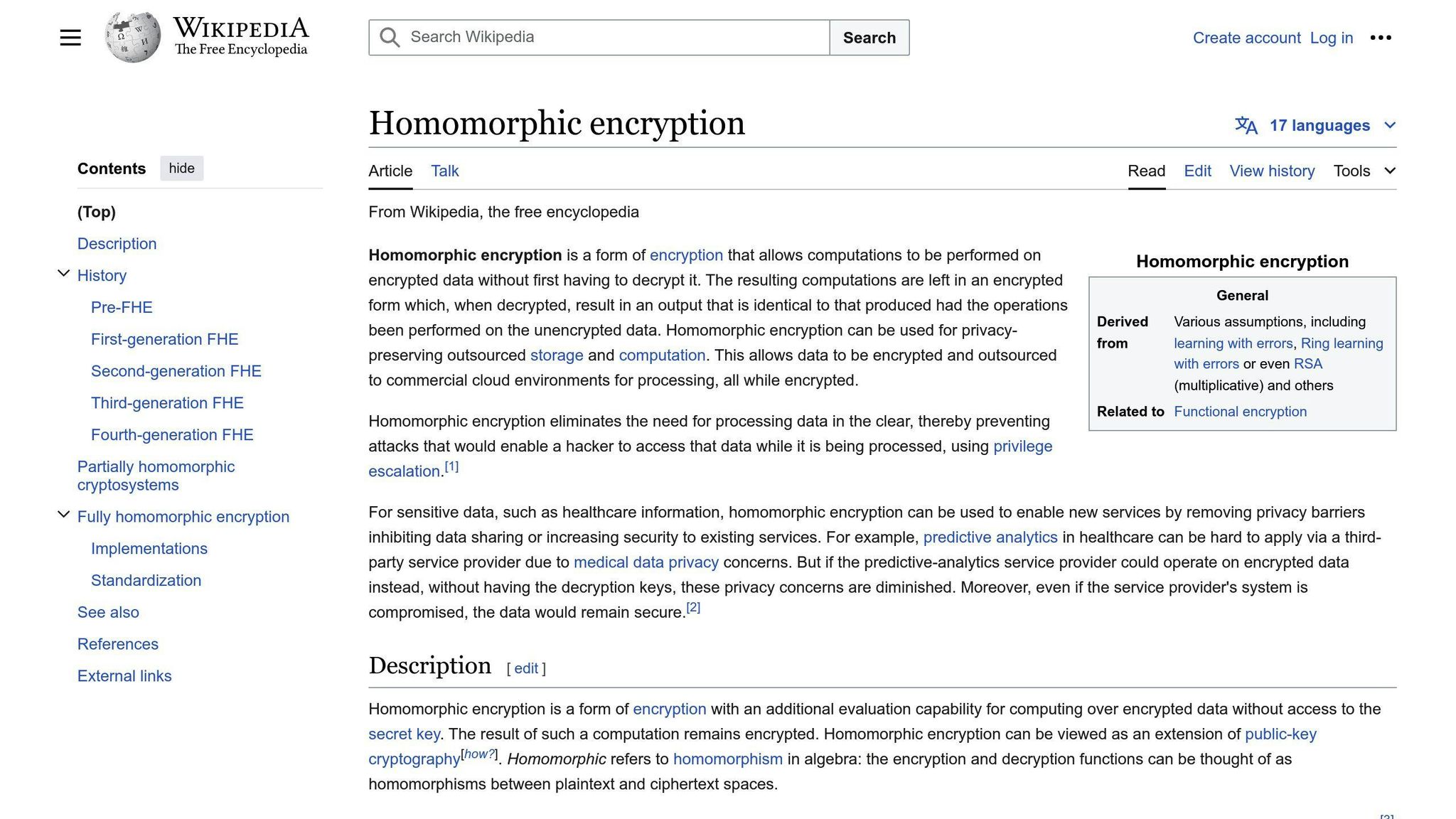
Homomorphic encryption allows computations to be performed on encrypted data without decrypting it first. This enables AI models to analyze sensitive information while keeping it encrypted, ensuring data confidentiality throughout the process.
There are different types of homomorphic encryption schemes:
- Partially Homomorphic Encryption: Supports either addition or multiplication operations on ciphertexts.
- Somewhat Homomorphic Encryption: Supports a limited number of operations.
- Fully Homomorphic Encryption: Supports arbitrary computations on ciphertexts.
While homomorphic encryption provides strong security, it often comes with significant computational overhead and efficiency challenges.
Secure Multi-Party Computation
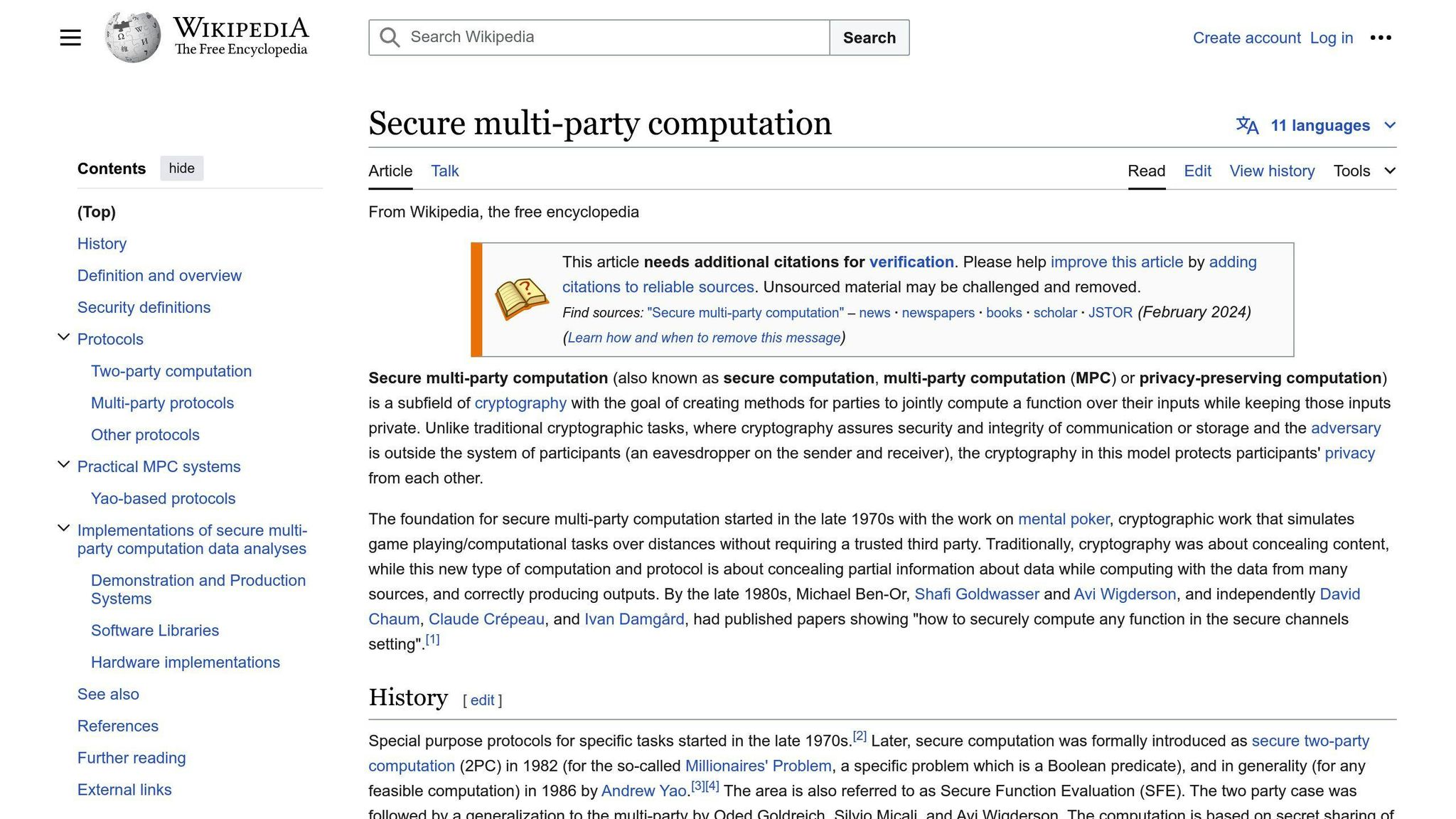
Secure multi-party computation (SMPC) enables multiple parties to collaboratively perform computations on their combined data without revealing their individual inputs. This is achieved through cryptographic protocols that ensure data privacy while still allowing the parties to obtain the desired output.
SMPC protocols, like Yao's Garbled Circuits and Secret Sharing, enable AI models to be trained on distributed data sources without exposing the raw data. However, SMPC can be computationally intensive and may have scalability limitations.
Federated Learning
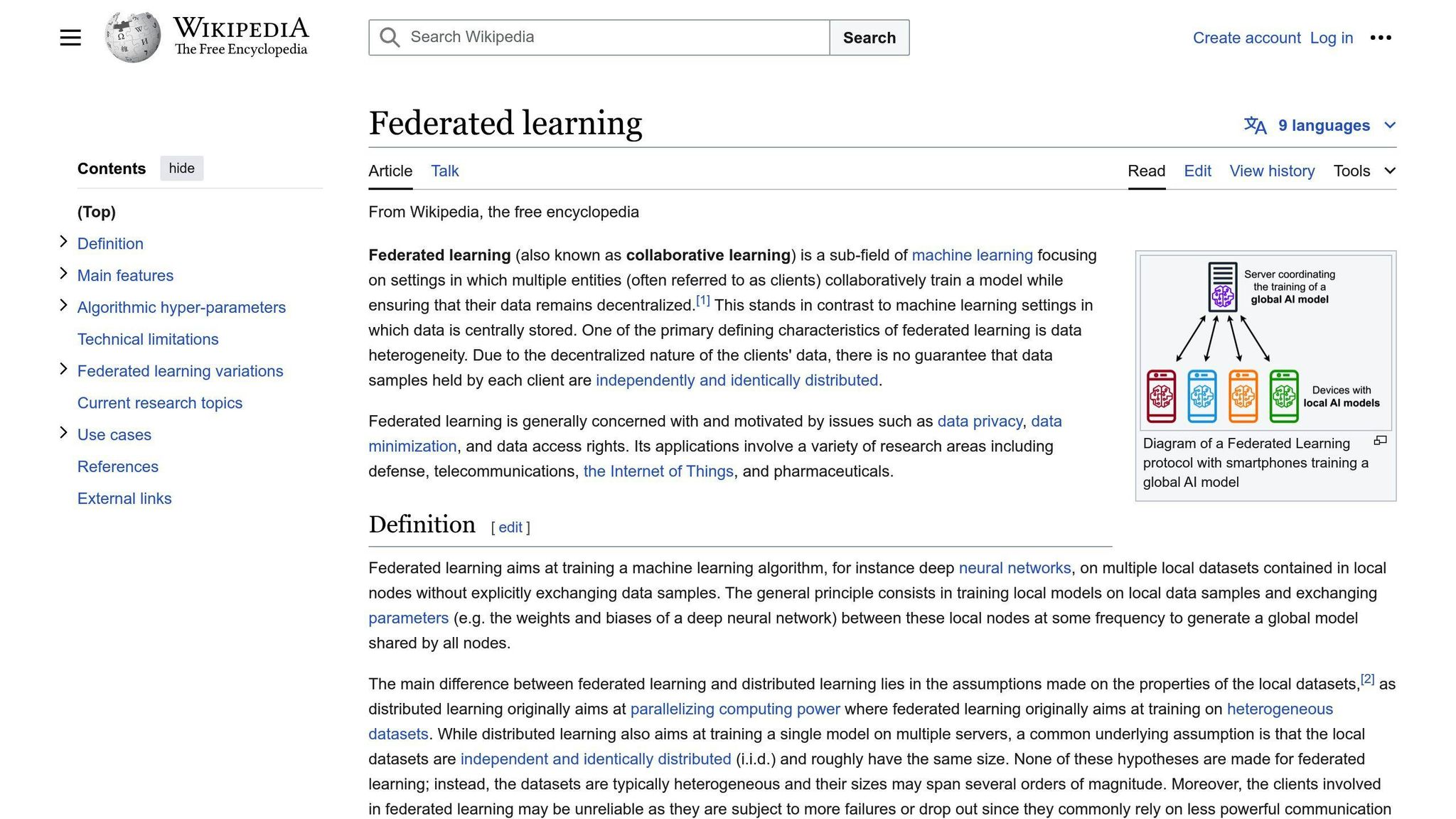
Federated learning is a decentralized approach to machine learning where the model is trained on data distributed across multiple devices or parties, without the need to centralize the data. Each device trains the model on its local data, and only the model updates are sent to a central server for aggregation.
This approach ensures that sensitive data never leaves the device, reducing privacy risks. Federated learning is particularly useful in scenarios where data is inherently distributed, such as in mobile devices or IoT networks.
Hybrid Approaches
In practice, combining multiple privacy-preserving techniques can provide stronger privacy guarantees and better utility trade-offs. Hybrid approaches, such as combining differential privacy with homomorphic encryption or federated learning, can leverage the strengths of different techniques while mitigating their individual limitations.
For example, combining differential privacy with federated learning can provide robust privacy protection while enabling collaborative model training on decentralized data sources. However, implementing hybrid approaches can be more complex and may require careful design and analysis.
| Technique | Description | Advantages | Disadvantages |
|---|---|---|---|
| Differential Privacy | Adds controlled noise to data to protect individual privacy | Strong privacy guarantees, quantifies privacy loss | May reduce data utility |
| Homomorphic Encryption | Performs computations on encrypted data without decrypting | Ensures data confidentiality, strong security | Computational overhead, efficiency challenges |
| Secure Multi-Party Computation | Enables collaborative computations without revealing individual inputs | Protects privacy in distributed settings | Computationally intensive, scalability limitations |
| Federated Learning | Trains models on decentralized data without centralization | Sensitive data never leaves device, useful for distributed data | Potential communication overhead |
| Hybrid Approaches | Combines multiple techniques to leverage their strengths | Stronger privacy guarantees, better utility trade-offs | Increased complexity, careful design required |
Privacy-Preserving Machine Learning Tools
Privacy-preserving machine learning tools help protect sensitive data while training AI models. These tools provide algorithms and infrastructure to develop privacy-focused models. Here, we explore popular frameworks, their features, and capabilities.
TensorFlow Privacy
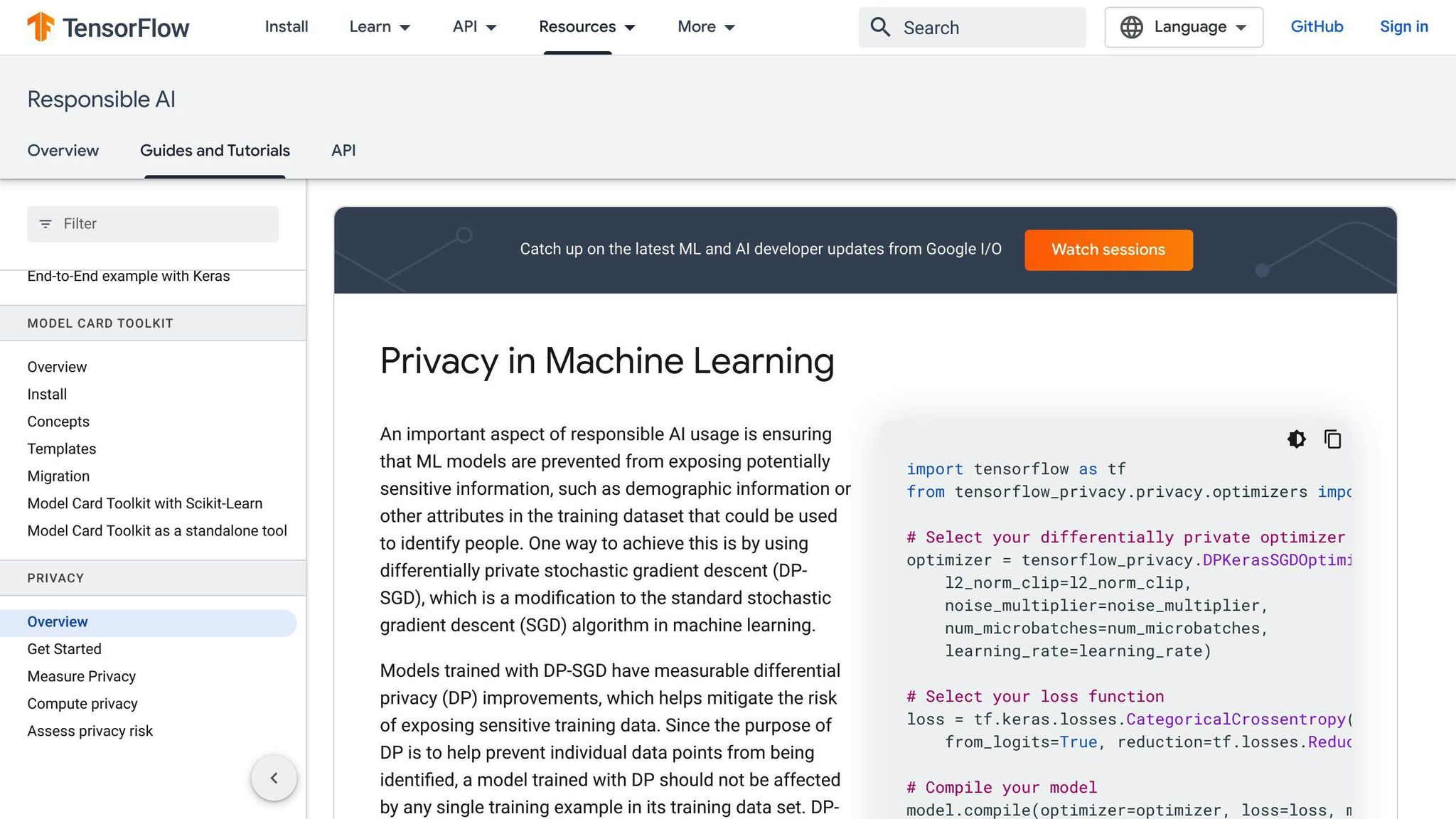
TensorFlow Privacy (TFP) is a Python toolbox for training machine learning models with differential privacy. Built on TensorFlow, TFP offers differentially private stochastic gradient descent (DP-SGD) algorithms. These algorithms add controlled noise to data, ensuring the model output doesn't reveal individual information. TFP also provides tools to calculate the privacy guarantees of the chosen mechanism, helping compare models in terms of privacy and utility.
OpenMined

OpenMined is an open-source framework for private and secure machine learning. Its PySyft library supports federated learning and differential privacy techniques. OpenMined offers tutorials and documentation to help developers get started with privacy-preserving machine learning.
PySyft
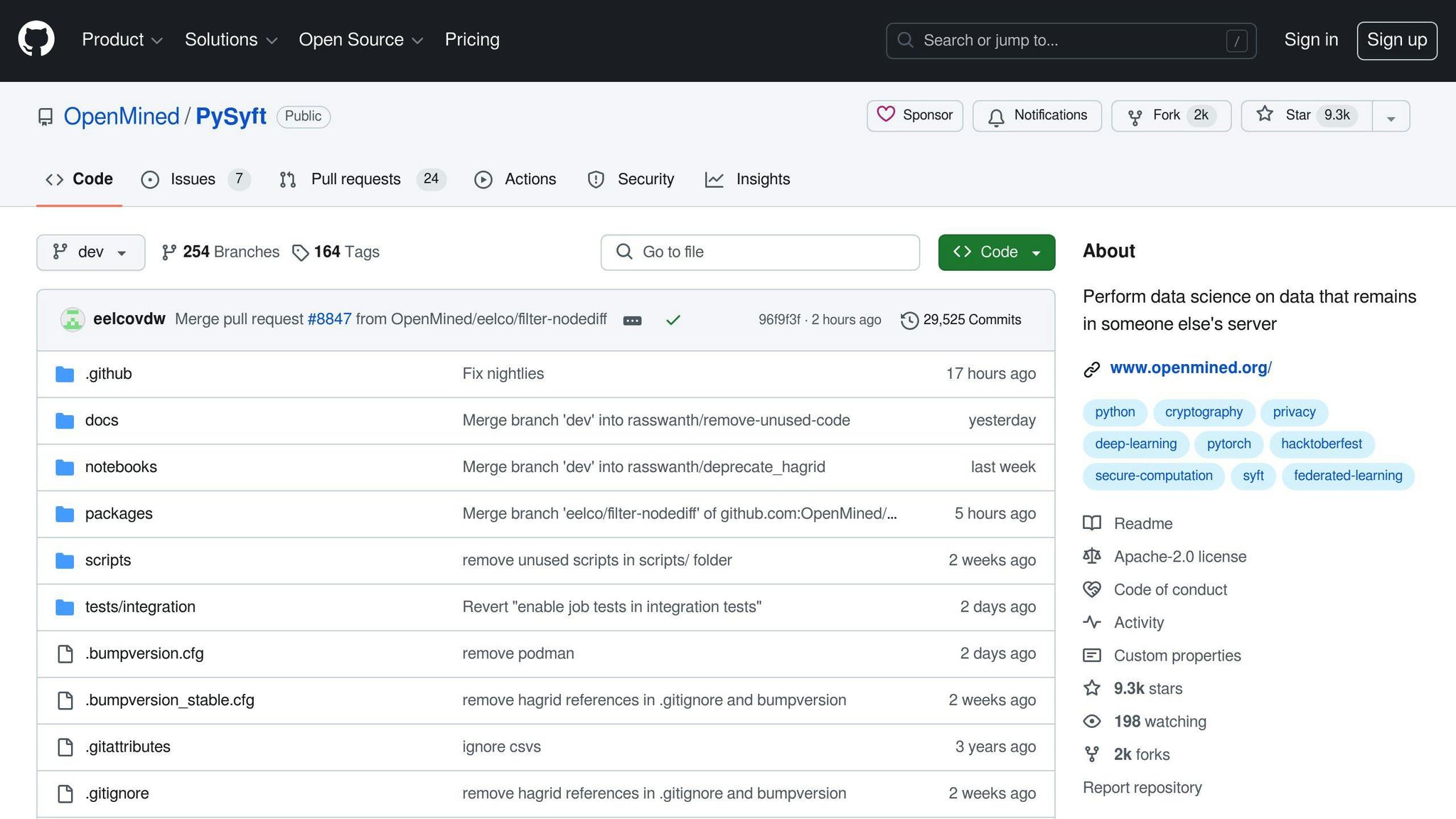
PySyft is a Python library for secure and private deep learning. It allows implementing federated learning and differential privacy techniques. PySyft supports popular deep learning frameworks like PyTorch and TensorFlow and integrates with OpenMined's ecosystem.
Framework Comparison
| Framework | Description | Ease of Use | Performance | Supported Techniques |
|---|---|---|---|---|
| TensorFlow Privacy | Differentially private machine learning | Medium | High | Differential Privacy |
| OpenMined | Private and secure machine learning | Medium | High | Federated Learning, Differential Privacy |
| PySyft | Secure and private deep learning | Easy | Medium | Federated Learning, Differential Privacy |
This table compares the frameworks based on their ease of use, performance, and supported techniques. TensorFlow Privacy is powerful for differential privacy but may require more expertise. OpenMined provides various tools for private and secure machine learning. PySyft is user-friendly for secure deep learning but may have lower performance.
Evaluating Privacy-Preserving AI
Assessing privacy-preserving AI techniques is crucial to safeguard sensitive data while maintaining model performance. This section discusses key metrics and benchmarks for evaluating privacy and utility.
Evaluation Metrics
When evaluating privacy-preserving AI techniques, consider both privacy and utility metrics:
- Privacy metrics: Measure the level of data protection offered.
- Differential privacy: Quantifies the maximum information an attacker can gain about an individual's data.
- Utility metrics: Assess the model's performance.
- Model accuracy: Evaluates performance on a specific task.
- Data utility: Measures the usefulness of data for training.
Technique Comparison
The table below compares the pros and cons of different privacy-preserving AI techniques:
| Technique | Pros | Cons |
|---|---|---|
| Differential Privacy | High privacy guarantees | Computationally expensive, may reduce accuracy |
| Homomorphic Encryption | Enables computations on encrypted data, high security | Computationally intensive, limited scalability |
| Secure Multi-Party Computation | Allows collaborative learning, high security | Computationally expensive, requires trust among parties |
| Federated Learning | Preserves data locality, high utility | May not provide strong privacy guarantees, requires significant communication |
| Hybrid Approaches | Combines benefits of multiple techniques | Increases complexity, may require significant expertise |
This table highlights the trade-offs between different techniques, allowing developers to choose the most suitable approach for their specific use case.
Challenges and Future Directions
As privacy-preserving AI advances, some issues need to be resolved for widespread adoption. This section discusses current limitations, ongoing research, and future trends.
Current Limitations
One key challenge is the trade-off between privacy and model performance. Techniques like differential privacy add noise to data to protect privacy, but this noise can reduce model accuracy. There is also a lack of standardization for implementing differential privacy.
Another limitation is the dependence on data quality. Federated learning relies on high-quality data from multiple sources, which can be difficult to ensure. Additionally, correlated data can compromise differential privacy's effectiveness.
Ongoing Research
Researchers are working on improving the accuracy of differentially private models while maintaining strong privacy. They are also developing more efficient and scalable algorithms for federated learning and secure multi-party computation.
Another area of focus is hybrid approaches that combine multiple techniques, such as differential privacy and homomorphic encryption. Researchers are also exploring ways to explain and interpret the decisions made by privacy-preserving AI models.
Future Trends
One trend is the increased adoption of federated learning in industries like healthcare and finance, where data privacy is crucial. Another trend is the development of more advanced differential privacy techniques, such as those that can handle correlated data and provide stronger privacy guarantees.
The integration of privacy-preserving AI with other technologies, like blockchain and edge computing, is also likely to gain traction. This integration could create more secure and decentralized AI systems that can operate at the network's edge.
Addressing current challenges and limitations through ongoing research and development is crucial for the future of privacy-preserving AI.
| Current Limitations | Ongoing Research | Future Trends |
|---|---|---|
| Trade-off between privacy and model performance | Improving accuracy of differentially private models | Increased adoption of federated learning in privacy-sensitive industries |
| Lack of standardization for differential privacy | More efficient and scalable algorithms for federated learning and secure multi-party computation | Development of advanced differential privacy techniques |
| Dependence on data quality | Hybrid approaches combining multiple techniques | Integration with blockchain and edge computing |
| Correlated data compromising differential privacy | Explaining and interpreting privacy-preserving AI models | More secure and decentralized AI systems |
Conclusion
Privacy-preserving AI is vital for protecting sensitive data while utilizing AI's benefits. As AI grows more widespread, safeguarding privacy is crucial for maintaining trust and transparency.
By adopting privacy-preserving techniques, businesses can ensure their AI systems respect privacy rights while remaining accurate and efficient. This builds customer trust, ensures regulatory compliance, and prevents reputational damage.
Moving forward, continuous research into new privacy-preserving methods is necessary to address emerging challenges. Doing so will enable responsible AI use that benefits society.
Key Points
- Privacy-preserving AI protects sensitive data while allowing AI insights
- Adopting these techniques builds customer trust and avoids legal issues
- Ongoing research is needed to develop new privacy-preserving methods
- Responsible AI use benefits society while respecting privacy rights
Advantages of Privacy-Preserving AI
| Advantage | Description |
|---|---|
| Data Protection | Safeguards sensitive personal information |
| Customer Trust | Prioritizing privacy builds loyalty and confidence |
| Regulatory Compliance | Helps organizations meet data privacy laws |
| Reputation Preservation | Reduces risks of data breaches and scandals |
Privacy-preserving AI enables organizations to harness AI's power while upholding ethical data practices. As AI evolves, prioritizing privacy will be essential for its widespread, responsible adoption.
Summarize with AI
Related Posts
Cross-Border AI Data Transfers: Navigating Challenges
Explore the complexities of cross-border AI data transfers, ensuring secure, compliant exchange amidst evolving global data protection laws and cybersecurity threats.
AI for Customer Data Security: 5 Best Practices
Explore 5 best practices for using AI to protect customer data security. Learn how AI can detect unusual activity, encrypt data, control access, anonymize data, and conduct regular security audits.
Ethical AI in Customer Service: Building Trust
Discover how ethical AI in customer service can enhance trust, reduce bias, and improve experiences with transparency, fairness, and data security.
AI Customer Service: Balancing Privacy & Innovation
Explore the intersection of AI customer service and privacy, uncovering the benefits, risks, and strategies for ethical AI implementation and customer data protection.
